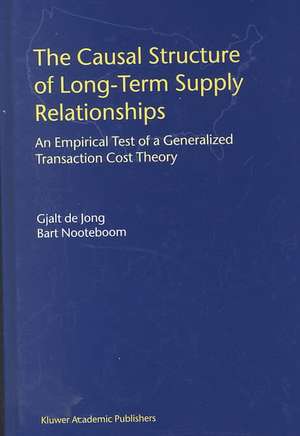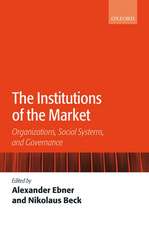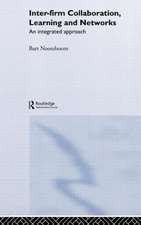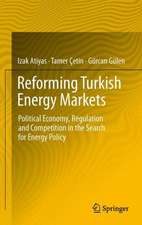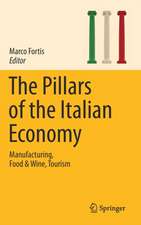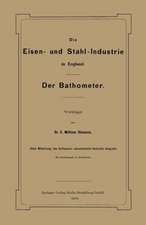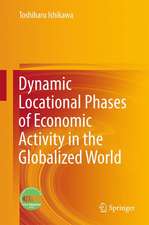The Causal Structure of Long-Term Supply Relationships: An Empirical Test of a Generalized Transaction Cost Theory
Autor Gjalt de Jong, Bart Nooteboomen Limba Engleză Hardback – 30 mai 2000
| Toate formatele și edițiile | Preț | Express |
|---|---|---|
| Paperback (1) | 938.51 lei 6-8 săpt. | |
| Springer Us – 12 iul 2013 | 938.51 lei 6-8 săpt. | |
| Hardback (1) | 944.51 lei 6-8 săpt. | |
| Springer Us – 30 mai 2000 | 944.51 lei 6-8 săpt. |
Preț: 944.51 lei
Preț vechi: 1151.84 lei
-18% Nou
Puncte Express: 1417
Preț estimativ în valută:
180.76€ • 186.73$ • 150.43£
180.76€ • 186.73$ • 150.43£
Carte tipărită la comandă
Livrare economică 25 martie-08 aprilie
Preluare comenzi: 021 569.72.76
Specificații
ISBN-13: 9780792378372
ISBN-10: 0792378377
Pagini: 172
Ilustrații: X, 155 p.
Dimensiuni: 170 x 244 x 15 mm
Greutate: 0.42 kg
Ediția:2000
Editura: Springer Us
Colecția Springer
Locul publicării:New York, NY, United States
ISBN-10: 0792378377
Pagini: 172
Ilustrații: X, 155 p.
Dimensiuni: 170 x 244 x 15 mm
Greutate: 0.42 kg
Ediția:2000
Editura: Springer Us
Colecția Springer
Locul publicării:New York, NY, United States
Public țintă
ResearchDescriere
Long-term supply relationships are of crucial importance in industrial organization. The present (r)evolution in information and communication technology such as e-business is proof of the increasingly dynamic environment in which firms operate. As a result, firms have to focus on their core competencies and obtain complementary ones from partner firms to be able to survive. This can hardly be realized without having long-term supply relationships. In the past decades, research on strategic alliances -the class of interfirm arrangements to which long-term supply relationships belong mushroomed. Many ofthe (empirical) studies in the alliance literature focus on a single variable that is then explained by a set of independent variables. For example, for international joint ventures the level of commitment, interdependence, asymmetry, and dedicated investments explains the development of trust. By itself there is nothing wrong in this approach. On the contrary, because of all these studies we now have some knowledge about the reasons why firms enter in alliances and why some alliances are more successful than others. In fact, one of our first studies also belonged to this research-tradition.
Cuprins
1 Introduction.- 1.1 Scope and Purpose.- 1.2 Overview of Theory.- 1.3 Overview of Empirical Results.- 2 Theoretical Background.- 2.1 Introduction.- 2.2 Transaction Cost Economics.- 2.3 Limitations of Transaction Cost Economics.- 2.4 Competencies.- 2.5 Relational Features.- 2.5.1 Commitment.- 2.5.2 Trust.- 2.6 Conclusions.- 3 The Theoretical Model.- 3.1 Introduction.- 3.2 Definitions and Related Research.- 3.3 The Theoretical Model.- 3.3.1 Asset Specificity.- 3.3.2 Uncertainty.- 3.3.3 Value of the Partner.- 3.3.4 Commitment.- 3.3.5 Trust.- 3.4 Conclusions.- 4 Methods and Data.- 4.1 Introduction.- 4.2 A LISREL Approach.- 4.2.1 Models, Methods and Matrices.- 4.2.2 Model-Fit and Model-Modification.- 4.3 The Samples.- 4.4 Operationalization.- 4.5 Conclusions.- 5 Empirical Results.- 5.1 Introduction.- 5.2 The United States.- 5.2.1 Measurement Models.- 5.2.2 Testing the Hypotheses and Model-Fit.- 5.3 Japan.- 5.3.1 Measurement Models.- 5.3.2 Testing the Hypotheses and Model-Fit.- 5.4 Europe.- 5.4.1 Measurement Models.- 5.4.2 Testing the Hypotheses and Model-Fit.- 5.5 Conclusions.- 6 An International Comparison.- 6.1 Introduction.- 6.2 The Convergence of Long-Term Supply Relationships.- 6.2.1 A First Perspective on the Convergence.- 6.2.2 The United States versus Japan.- 6.2.3 The United States versus Europe.- 6.2.4 Japan versus Europe.- 6.3 The Third Way.- 6.4 Causal Loops.- 6.5 Conclusions.- 6.5.1 Point of Departure.- 6.5.2 Convergence within the Triad.- 6.5.3 Explaining the Convergence.- 6.5.4 Limitations and Further Research.- Appendix A Constructs, Items And Scales.
